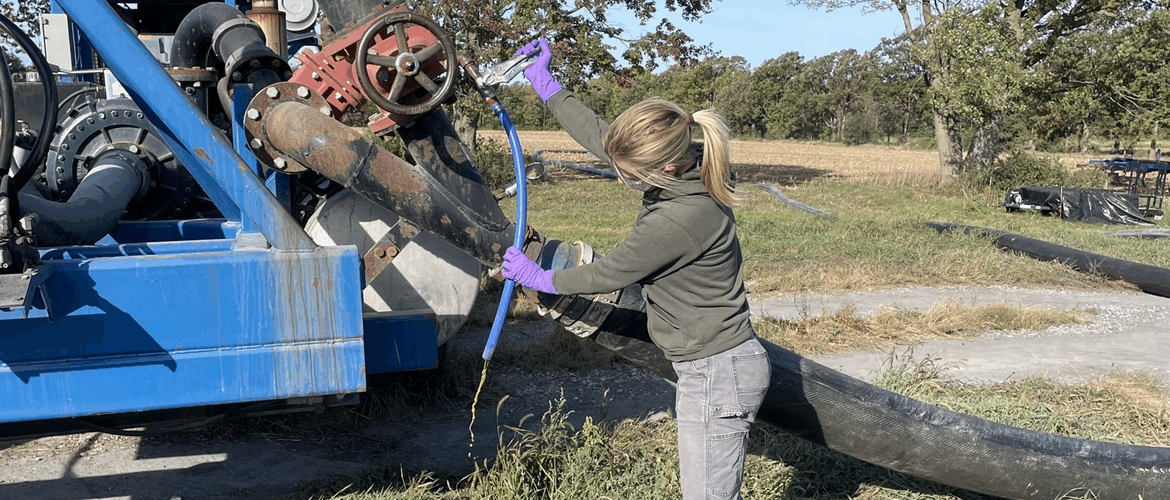
Site Drop-in: University of Vermont focuses heavily on water quality
June 25, 2025
Eight research institutions across the country are participating in the Dairy Soil & Water Regeneration (DSWR) project. Joshua Faulkner, a scientist at the University of Vermont, provided an update on what’s happening there.
Research focus: The DSWR work in Vermont occurs at two different field sites. One site (VB) is located on a commercial farm in the southern part of the Lake Champlain Basin, not too far from Middlebury. The other site (VA) is located on a research field that the University of Vermont is leasing from a farm in the northern part of the Basin, near St. Albans.
At both sites, we are comparing dairy forage production systems using conventional field practices to a soil health management system. We are also evaluating a novel manure product, flocculated solids, at the VB site. Monitoring is also more intensive at this site, which is where we are measuring greenhouse gas (GHG) emissions and carbon content in deeper soils.
Phosphorus runoff into Lake Champlain is a significant concern in our state, similar to other states with significant agricultural land use. As a result, we are also measuring water quality parameters at both of the study sites. At VB, we collect edge-of-field surface and subsurface (i.e., tile drainage) runoff from the different treatments and analyze samples for nitrogen, phosphorus, and sediment concentrations and loads. We are also evaluating the performance of phosphorus filters on the tile drainage outlets.
At VA, we also collect edge-of-field runoff, but there we have the ability to compare undrained to drained fields; two of our large study plots have tile drainage and two do not. We strive to collect runoff data throughout the entire year, which can be a significant challenge during freeze-thaw conditions in Vermont.
Another key focus of our research is related to how high and low points of the landscape in an agricultural field respond differently in terms of soil health and GHG emissions. This question is a result of variable yield observations in very wet growing seasons, and the recognition that climate change projections indicate our region will continue to get wetter. For this work, we have installed sensor systems in distinct high and low points at each study site, which are also the locations where we perform our regular soil health sampling and GHG measurements.
What’s happening now: We have had a cool, wet spring in Vermont, so planting has been delayed on many farms. However, our team is gearing up for a busy period of soil health sampling once planting has occurred. Even though we have been delayed getting into the field for soil sampling, the upside of wet field conditions is that we are busy collecting water quality data from multiple runoff events. Our GHG measurement work is preceding full speed ahead.
Findings to date: Following an unseasonably heavy rainfall in 2023, total carbon, total nitrogen and soil bulk density differed across low and high points at VB. We also found that soil health management practices offer potential benefits for soil health and yields; at the same time, those practices have shown increased nitrous oxide emissions in the low areas of the field. Relatedly, methane emissions were the greatest from the soil health treatment, and the low areas of the field across all treatments. The treatment area receiving the novel manure products had the lowest GHG emissions, but also the lowest yields. One of our edge-of-field phosphorus filters performed especially well, removing 80% of total phosphorus and 95% of soluble phosphorus from tile drainage effluent over a two-year period. We don’t yet have enough data to draw definitive conclusions, and for the research to be effective it will need to span several growing seasons, with much to still discover.
Key challenge: Weather. We have experienced two extremely wet growing seasons. In fact, July and August in 2023 were the wettest ever recorded in our study area. This creates a significant challenge for our partner farms, but also for us in terms of accessing and working in the fields in the heavy clay soils.
Key success: Maintaining two fully functioning research sites and successfully meeting soil, GHG, yield and water quality data collection goals, all while having fun as a research team. We are looking forward to sharing our data with stakeholders in our region and beyond in the coming months.